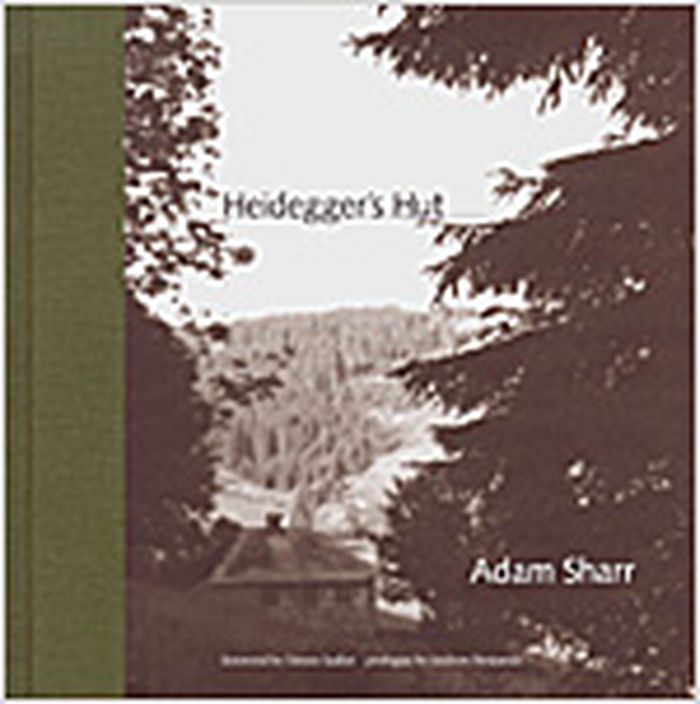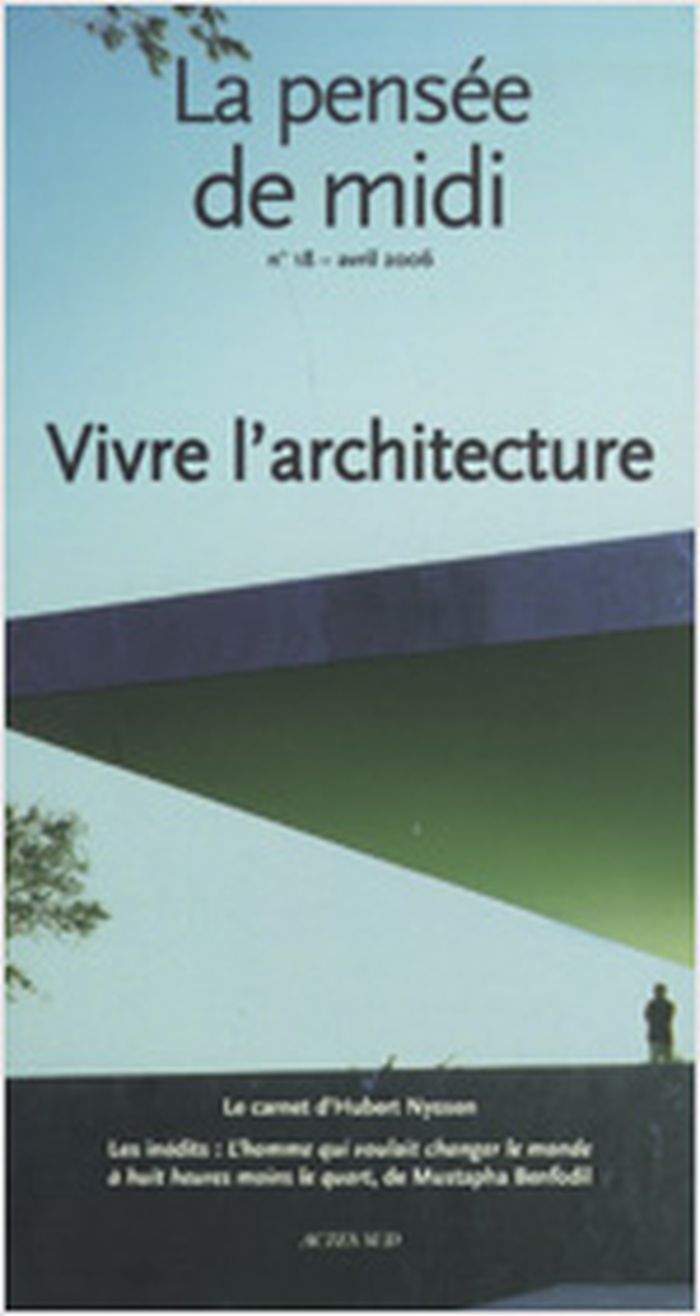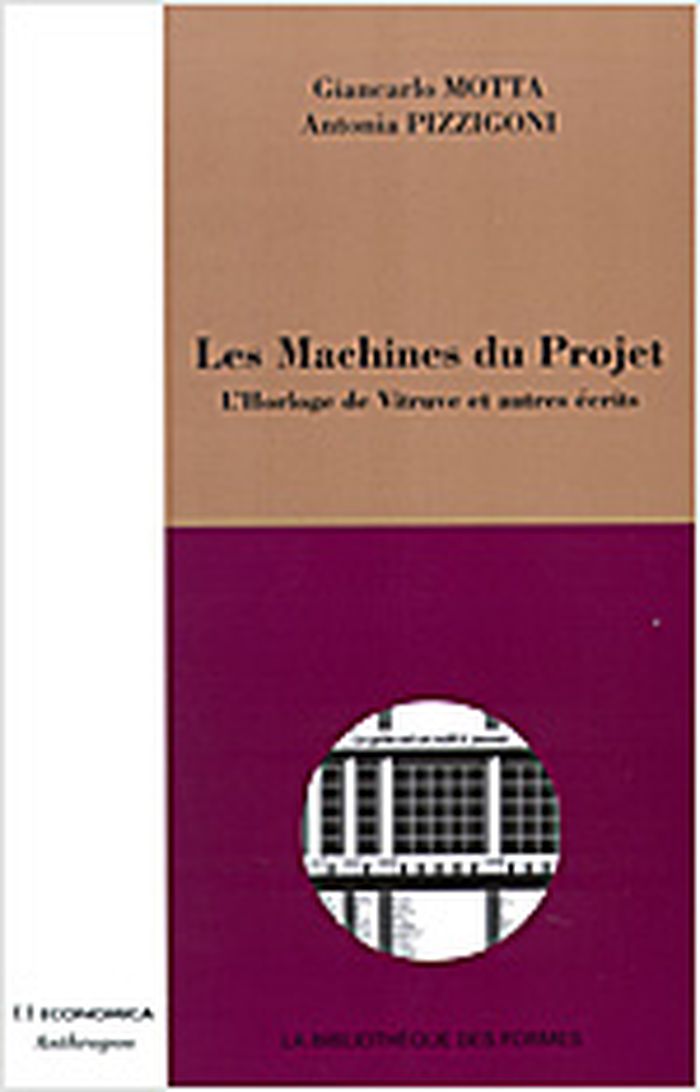$42.95
(disponible sur commande)
Résumé:
Manifeste autant qu'analyse, cet ouvrage constitue un plaidoyer pour la nécessité d'un superflu. S'élevant contre les excès du fonctionalisme ambiant, Robert Venturi montre, à l'aide de quelques deux cents exemples puisés dans le patrimoine commun des civilisations occidentales qu'une œuvre architecturale répond à plusieurs fins : il démontre qu'il est possible d'assurer(...)
De l'ambiguité en architecture
Actions:
Prix:
$42.95
(disponible sur commande)
Résumé:
Manifeste autant qu'analyse, cet ouvrage constitue un plaidoyer pour la nécessité d'un superflu. S'élevant contre les excès du fonctionalisme ambiant, Robert Venturi montre, à l'aide de quelques deux cents exemples puisés dans le patrimoine commun des civilisations occidentales qu'une œuvre architecturale répond à plusieurs fins : il démontre qu'il est possible d'assurer la complexité et la contradiction et, sans nuire à la fonction, de doter l'œuvre d'une ambiguïté enrichissante.
Théorie de l’architecture
$25.95
(disponible sur commande)
Résumé:
From the Gothic to the contemporary, glass has transformed the structural, formal, and philosophical principles of architecture. In "The glass state", Annette Fierro views the many meanings of transparency in architecture. Specifically, she analyzes the transparent monumental buildings that were built in Paris between 1981 and 1998 as part of Francois Mitterrand's program(...)
avril 2009
The glass state: the technology of the spectacle, Paris 1981-1998
Actions:
Prix:
$25.95
(disponible sur commande)
Résumé:
From the Gothic to the contemporary, glass has transformed the structural, formal, and philosophical principles of architecture. In "The glass state", Annette Fierro views the many meanings of transparency in architecture. Specifically, she analyzes the transparent monumental buildings that were built in Paris between 1981 and 1998 as part of Francois Mitterrand's program of Grands Projets. The Grands Projets provide a rare opportunity to study a finite set of buildings constructed of similar materials, in the same time period, in a specific urban landscape, and with related ideological missions. Fierro employs a "discourse of the detail," in which the smallest architectural detail manifests the political, theoretical, and urban contexts of the building's design and construction. She examines the paradox of the most pared down architectural configurations being used to support the most complex meanings. Intrinsic to Mitterrand's glass buildings in Paris, for example, is a political concept: the metaphor of accessibility as a means of breaking open cultural institutions previously closed to the public. In addition to the structures of the Grands Projets - the Institut du Monde Arabe, the Grande and Petite Pyramides du Louvre, the glass greenhouses at utopian park projects at La Villette and André Citroën and the Bibliotheque nationale de France - Fierro discusses the Fondation Cartier and two precedent structures, the Centre Georges Pompidou and the Eiffel Tower.
$31.50
(disponible sur commande)
Résumé:
In this long-awaited work, Dalibor Vesely proposes an alternative to the narrow vision of contemporary architecture as a discipline that can be treated as an instrument or commodity. In doing so, he offers an account of the ontological and cultural foundations of modern architecture and, consequently, of the nature and cultural role of architecture through history.(...)
Théorie de l’architecture
octobre 2006, Cambridge (MA), London
Architecture in the age of divided representation : the question of creativity in the shadow of production
Actions:
Prix:
$31.50
(disponible sur commande)
Résumé:
In this long-awaited work, Dalibor Vesely proposes an alternative to the narrow vision of contemporary architecture as a discipline that can be treated as an instrument or commodity. In doing so, he offers an account of the ontological and cultural foundations of modern architecture and, consequently, of the nature and cultural role of architecture through history. Vesely's argument, structured as a critical dialogue, discovers the first plausible anticipation of modernity in the formation of Renaissance perspective. Understanding this notion of perspective against the background of the medieval philosophy of light, he argues, leads to an understanding of architectural space as formed by typical human situations and by light before it is structured geometrically. The central part of the book addresses the question of divided representation - the tension between the instrumental and the communicative roles of architecture - in the period of the baroque, when architectural thinking was seriously challenged by the emergence of modern science. Vesely argues that to resolve the dilemma of modernity - reconciling the inventions and achievements of modern technology with the human condition and the natural world - we can turn to architecture and its latent capacity to reconcile different levels of reality, its ability to relate abstract ideas and conceptual structures to the concrete situations of everyday life. Vesely sees the restoration of this communicative role of architecture as the key to the restoration of architecture as the topological and corporeal foundation of culture; what the book is to our literacy, he argues, architecture is to culture as a whole. He concludes by proposing a new poetics of architecture that will serve as a framework for the restoration of the humanistic role of architecture in the age of technology.
Théorie de l’architecture
Heidegger's hut
$32.95
(disponible sur commande)
Résumé:
"This is the most thorough architectural 'crit' of a hut ever set down, the justification for which is that the hut was the setting in which Martin Heidegger wrote phenomenological texts that became touchstones for late-twentieth-century architectural theory." --from the foreword by Simon Sadler Beginning in the summer of 1922, philosopher Martin Heidegger(...)
Théorie de l’architecture
octobre 2006, Cambridge / London
Heidegger's hut
Actions:
Prix:
$32.95
(disponible sur commande)
Résumé:
"This is the most thorough architectural 'crit' of a hut ever set down, the justification for which is that the hut was the setting in which Martin Heidegger wrote phenomenological texts that became touchstones for late-twentieth-century architectural theory." --from the foreword by Simon Sadler Beginning in the summer of 1922, philosopher Martin Heidegger (1889-1976) occupied a small, three-room cabin in the Black Forest Mountains of southern Germany. He called it "die Hütte" ("the hut"). Over the years, Heidegger worked on many of his most famous writings in this cabin, from his early lectures to his last enigmatic texts. He claimed an intellectual and emotional intimacy with the building and its surroundings, and even suggested that the landscape expressed itself through him, almost without agency. In Heidegger's Hut, Adam Sharr explores this intense relationship of thought, place, and person. Heidegger's mountain hut has been an object of fascination for many, including architects interested in his writings about "dwelling" and "place." Sharr's account--the first substantive investigation of the building and Heidegger's life there--reminds us that, in approaching Heidegger's writings, it is important to consider the circumstances in which the philosopher, as he himself said, felt "transported" into the work's "own rhythm." Indeed, Heidegger's apparent abdication of agency and tendency toward romanticism seem especially significant in light of his troubling involvement with the Nazi regime in the early 1930s. Sharr draws on original research, including interviews with Heidegger's relatives, as well as on written accounts of the hut by Heidegger and his visitors. The book's evocative photographs include scenic and architectural views taken by the author and many remarkable images of a septuagenarian Heidegger in the hut taken by the photojournalist Digne Meller-Markovicz. There are many ways to interpret Heidegger's hut--as the site of heroic confrontation between philosopher and existence; as the petit bourgeois escape of a misguided romantic; as a place overshadowed by fascism; or as an entirely unremarkable little building. Heidegger's Hut does not argue for any one reading, but guides readers toward their own possible interpretations of the importance of "die Hütte."
Théorie de l’architecture
$47.75
(disponible en magasin)
Résumé:
Comment comprendre l'architecture? Comment rendre compte de ce qui est à la fois expérience perceptive, projet artistique, décision d'urbanisme et choix politique? " Le plan et le détail " expose la philosophie d'un nouvel esprit architectural, déconstruit et remodèle les convictions et les notions sur lesquelles se fonde le travail de l'architecte : la valeur du plan,(...)
Le plan et le détail : une philosophie de l'architecture et de la ville
Actions:
Prix:
$47.75
(disponible en magasin)
Résumé:
Comment comprendre l'architecture? Comment rendre compte de ce qui est à la fois expérience perceptive, projet artistique, décision d'urbanisme et choix politique? " Le plan et le détail " expose la philosophie d'un nouvel esprit architectural, déconstruit et remodèle les convictions et les notions sur lesquelles se fonde le travail de l'architecte : la valeur du plan, la construction du cadre de l'habitat, l'insertion du bâti dans le tissu urbain, la relation de l'architecture et de l'urbanisme, le rationalisme technique, l'invention du détail. L'auteur permet de repenser les problèmes généraux de l'espace urbain aujourd'hui - dans un dialogue serré et fécond avec de grands créateurs du XX°siècle, et avec leurs oeuvres : Loos et Le Corbusier, Mies van der Rohe, Louis Kahn, Aldo Rossi, Peter Eisenman, et Rem Koolhaas. Fortement documenté, et illustré (52 illustrations et photographies noir et blanc; 8 planches couleurs).
Théorie de l’architecture
$28.50
(disponible sur commande)
Résumé:
Architecte urbaniste, Nicolas Michelin prend la parole et témoigne du rôle de l’architecte face aux enjeux majeurs de la société aujourd’hui. En prise avec l’actualité - crise des banlieues, développement durable -, mais aussi avec les conditions d’exercice de l’architecture - contrainte des programmes, standardisation des typologies, poids des normes, carcan des(...)
Avis : propos sur l'architecture, la ville, l'environnement
Actions:
Prix:
$28.50
(disponible sur commande)
Résumé:
Architecte urbaniste, Nicolas Michelin prend la parole et témoigne du rôle de l’architecte face aux enjeux majeurs de la société aujourd’hui. En prise avec l’actualité - crise des banlieues, développement durable -, mais aussi avec les conditions d’exercice de l’architecture - contrainte des programmes, standardisation des typologies, poids des normes, carcan des budgets - les textes réunis ici sont l’expression de préoccupations et de réflexions sur le rôle de l’architecte aujourd’hui. Avant-propos de Catherine Pierre.
Théorie de l’architecture
$34.50
(disponible sur commande)
Résumé:
Collection of lectures, presented at various occasions over the last twenty years, wherein Antonio Monestiroli argues for the need of a theory of design based on a unitary viewpoint on architecture in a time when such a viewpoint seems to be lost.
The metope and the triglyph : nine lectures in architecture
Actions:
Prix:
$34.50
(disponible sur commande)
Résumé:
Collection of lectures, presented at various occasions over the last twenty years, wherein Antonio Monestiroli argues for the need of a theory of design based on a unitary viewpoint on architecture in a time when such a viewpoint seems to be lost.
Théorie de l’architecture
livres
$44.95
(disponible sur commande)
Résumé:
In this rapidly globalizing world, any investigation of architecture inevitably leads to considerations of regionalism. But despite its omnipresence in contemporary practice and theory, architectural regionalism remains a fluid concept, its historical development and current influence largely undocumented. This comprehensive reader brings together over 40 key essays(...)
Architectural regionalism : collected writings on place, identity, modernity, and tradition
Actions:
Prix:
$44.95
(disponible sur commande)
Résumé:
In this rapidly globalizing world, any investigation of architecture inevitably leads to considerations of regionalism. But despite its omnipresence in contemporary practice and theory, architectural regionalism remains a fluid concept, its historical development and current influence largely undocumented. This comprehensive reader brings together over 40 key essays illustrating the full range of ideas embodied by the term. Authored by important critics, historians, and architects such as Kenneth Frampton, Lewis Mumford, Sigfried Giedion, and Alan Colquhoun, Architectural Regionalism represents the history of regionalist thinking in architecture from the early twentieth century to today.
livres
mai 2007, New York
Théorie de l’architecture
$27.50
(disponible en magasin)
Résumé:
L'architecture est à la mode, et pourtant elle n'a jamais autant manqué à notre culture commune. A l'heure où des objets architecturaux spectaculaires mais coupés de la vie sociale semblent l'emporter sur le rêve collectif, La pensée de midi a convié architectes, urbanistes, paysagistes, designers, historiens et écrivains à faire le point sur notre manière d'habiter le(...)
La pensée de midi no. 18 : vivre l'architecture
Actions:
Prix:
$27.50
(disponible en magasin)
Résumé:
L'architecture est à la mode, et pourtant elle n'a jamais autant manqué à notre culture commune. A l'heure où des objets architecturaux spectaculaires mais coupés de la vie sociale semblent l'emporter sur le rêve collectif, La pensée de midi a convié architectes, urbanistes, paysagistes, designers, historiens et écrivains à faire le point sur notre manière d'habiter le monde, singulièrement en Méditerranée. Un dossier pour réinventer d'autres façons de vivre ensemble dans l'espace urbain.
Théorie de l’architecture
$39.95
(disponible en magasin)
Résumé:
En Europe un débat existe qui vise à comprendre si l'on peut, aujourd'hui, parler de recherche sur le projet en architecture. Et encore, quelle devrait être une recherche sur le projet ? Est-il possible de trouver une relation entre la recherche et la pratique du projet ? " Les machines du projet " constituent la réponse que les auteurs donnent aux questions posées à(...)
Théorie de l’architecture
avril 2006, Paris
Les machines du projet : l'horloge de Vitruve et autres écrits
Actions:
Prix:
$39.95
(disponible en magasin)
Résumé:
En Europe un débat existe qui vise à comprendre si l'on peut, aujourd'hui, parler de recherche sur le projet en architecture. Et encore, quelle devrait être une recherche sur le projet ? Est-il possible de trouver une relation entre la recherche et la pratique du projet ? " Les machines du projet " constituent la réponse que les auteurs donnent aux questions posées à partir d'un travail de recherche d'une dizaine d'années. Ce livre veut documenter cette recherche qui considère le projet surtout comme une manière d'étudier l'architecture ainsi que comme un instrument pour la produire. Reconnaître le rôle que les techniques jouent dans le projet, en particulier celles de la représentation, ouvre le chemin à l'étude de son fonctionnement. La nature technique de ses procédés permet de parler du projet comme d'une " machine ". De cette machine dépend la possibilité du projet de se situer au centre de l'instabilité et de régir les contradictions entre nouveauté et tradition, entre généralités et apports personnels, entre archétypes et solutions que la pensée moderne a introduites dans l'architecture. C'est le cas des relations entre la tradition du projet d'architecture et le rapide développement des technologies informatiques.
Théorie de l’architecture








